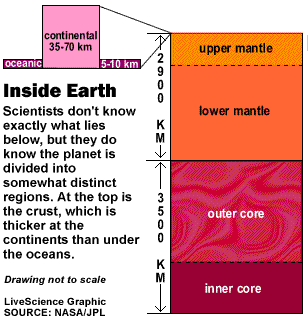| Tweet |

上の図の説明
What's Down There
The Earth’s radius is about 4,000 miles (6,400 kilometers). The main layers of its interior are in descending order: crust, mantle and core.
The crust thickness averages about 18 miles (30 kilometers) under the continents, but is only about 3 miles (5 kilometers) under the oceans. It is light and brittle and can break. In fact it's fractured into more than a dozen major plates and several minor ones. It is where most earthquakes originate.
The mantle is more flexible – it flows instead of fractures. It extends down to about 1,800 miles (2,900 kilometers) below the surface.
The core consists of a solid inner core and a fluid outer core. The fluid contains iron, which, as it moves, generates the Earth’s magnetic field. The crust and upper mantle form the lithosphere, which is broken up into several plates that float on top of the hot molten mantle below.
SOURCE: LiveScience reporting
ーーーーーーーーーーーーーーーーーーーーーーーーーーーーーーーーーーーーーーーーー
2月28日付け、「Live Science」より、地球の内部に巨大な”海洋”を発見したというニュース。
地球内部を精密調査している科学者たちは、東アジアが位置する地球の内部に、少なくとも北極海に相当する巨大な海洋が存在する証拠を発見した。地球の深層部にこのような発見がなされたのは、これが最初。
これを発見したのはセントルイスにあるワシントン州立大学の地震学者、Michael Wysessionと彼の元教え子であり、現在はカリフォルニア大学サンディエゴ校の研究者であるJesse Lawrence。二人は今度発行されるAmerican Geophysical Unionの論文の中で詳細に記述している。
http://www.livescience.com/environment/070228_beijing_anomoly.html
Huge 'Ocean' Discovered Inside Earth
By Ker Than
LiveScience Staff Writer
posted: 28 February 2007
01:28 pm ET
Scientists scanning the deep interior of Earth have found evidence of a vast water reservoir beneath eastern Asia that is at least the volume of the Arctic Ocean.
The discovery marks the first time such a large body of water has found in the planet’s deep mantle.
The finding, made by Michael Wysession, a seismologist at Washington State University in St. Louis, and his former graduate student Jesse Lawrence, now at the University of California, San Diego, will be detailed in a forthcoming monograph to be published by the American Geophysical Union.
Looking down deep
The pair analyzed more than 600,000 seismograms—records of waves generated by earthquakes traveling through the Earth—collected from instruments scattered around the planet.
They noticed a region beneath Asia where seismic waves appeared to dampen, or “attenuate,” and also slow down slightly. “Water slows the speed of waves a little,” Wysession explained. “Lots of damping and a little slowing match the predictions for water very well.”
Earth Facts
Previous predictions calculated that if a cold slab of the ocean floor were to sink thousands of miles into the Earth’s mantle, the hot temperatures would cause water stored inside the rock to evaporate out.
“That is exactly what we show here,” Wysession said. “Water inside the rock goes down with the sinking slab and it’s quite cold, but it heats up the deeper it goes, and the rock eventually becomes unstable and loses its water.”
The water then rises up into the overlying region, which becomes saturated with water [image]. “It would still look like solid rock to you,” Wysession told LiveScience. “You would have to put it in the lab to find the water in it.”
Although they appear solid, the composition of some ocean floor rocks is up to 15 percent water. “The water molecules are actually stuck in the mineral structure of the rock,” Wysession explained. “As you heat this up, it eventually dehydrates. It’s like taking clay and firing it to get all the water out.”
The researchers estimate that up to 0.1 percent of the rock sinking down into the Earth’s mantle in that part of the world is water, which works out to about an Arctic Ocean’s worth of water.
“That’s a real back of the envelope type calculation,” Wysession said. “That’s the best that we can do at this point.”
The Beijing anomaly
Wysession has dubbed the new underground feature the “Beijing anomaly,” because seismic wave attenuation was found to be highest beneath the Chinese capital city. Wysession first used the moniker during a presentation of his work at the University of Beijing.
“They thought it was very, very interesting,” Wysession said. “China is under greater seismic risk than just about any country in the world, so they are very interested in seismology.”
Water covers 70 percent of Earth’s surface and one of its many functions is to act like a lubricant for the movement of continental plates.
“Look at our sister planet, Venus,” Wysession said. “It is very hot and dry inside Venus, and Venus has no plate tectonics. All the water probably boiled off, and without water, there are no plates. The system is locked up, like a rusty Tin Man with no oil.”
Hole Drilled to Bottom of Earth's Crust
Earth's Core Rotates Faster than Surface, Study Confirms
Giant Slab of Earth's Crust Found Near Core
Top 10 Ways to Destroy Earth
|
|
▲このページのTOPへ HOME > Ψ空耳の丘Ψ47掲示板
フォローアップ:- Re: 米科学者、東アジアが位置する地球内部に巨大な 凡人 2007/3/01 21:15:15
(3)
- 北京と特定している理由を推測すると・・ Sun Shine 2007/3/02 18:05:33
(2)
- Re: 北京と特定している理由を推測すると・・ 凡人 2007/3/02 19:34:16
(1)
- Re: いいポイントだと思いました Sun Shine 2007/3/03 06:47:36
(0)
- Re: いいポイントだと思いました Sun Shine 2007/3/03 06:47:36
(0)
- Re: 北京と特定している理由を推測すると・・ 凡人 2007/3/02 19:34:16
(1)
- 北京と特定している理由を推測すると・・ Sun Shine 2007/3/02 18:05:33
(2)
|
|
投稿コメント全ログ コメント即時配信 スレ建て依頼 削除コメント確認方法
|
|
 題名には必ず「阿修羅さんへ」と記述してください。
題名には必ず「阿修羅さんへ」と記述してください。
掲示板,MLを含むこのサイトすべての
一切の引用、転載、リンクを許可いたします。確認メールは不要です。
引用元リンクを表示してください。
|
|
|
|
|
|
|
|